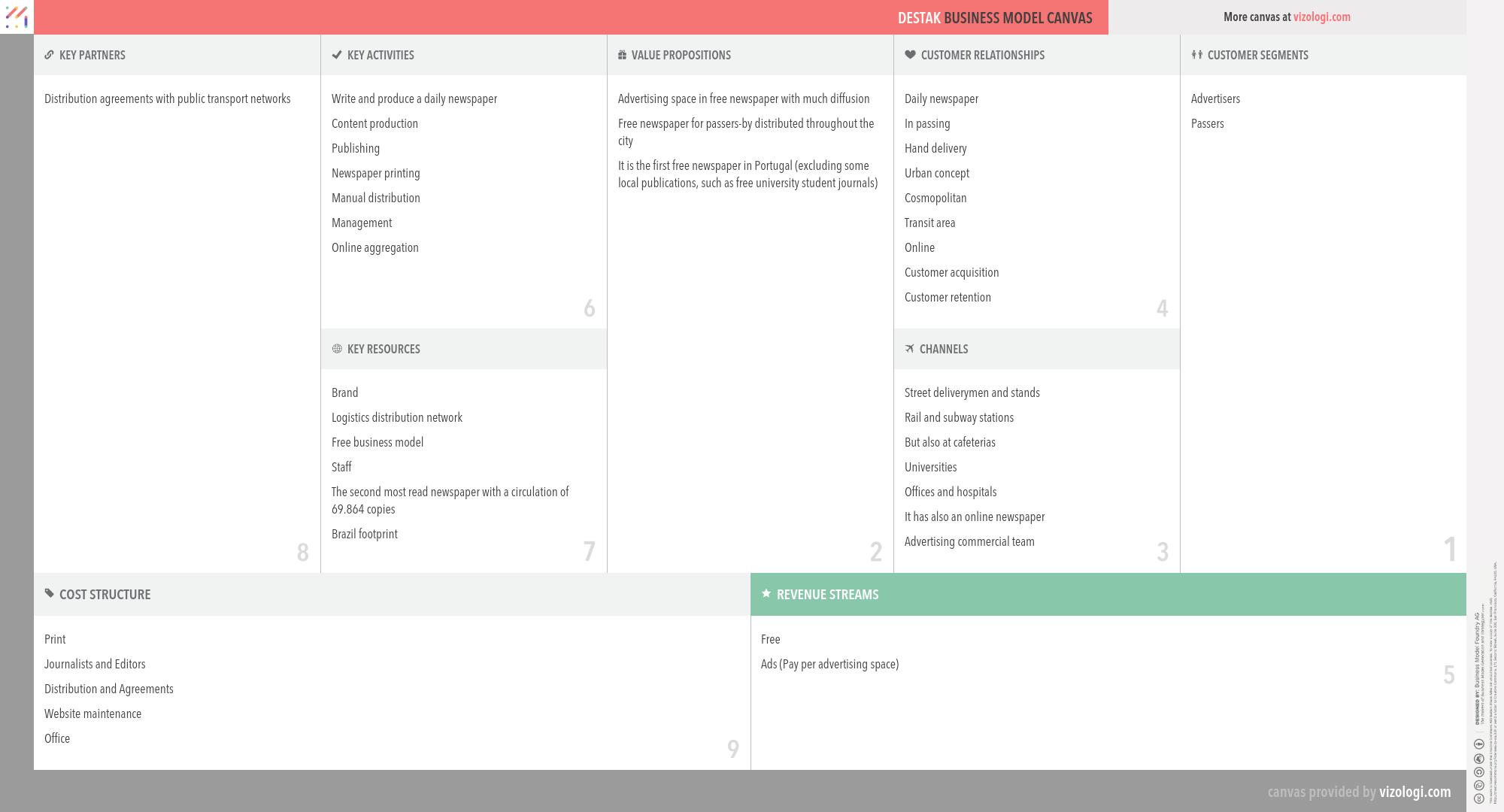Why Destak's Business Model is so successful?
Get all the answers 
Destak’s Company Overview
Destak is a Portuguese free daily newspaper, which is distributed in Lisbon, Porto and Coimbra, and also other Portuguese cities. It is the first free newspaper in Portugal (excluding some local publications, such as free university student journals), prior to the Portuguese edition of Metro International. The paper is chiefly offered at rail and subway stations, but also at cafeterias, universities, offices and hospitals. It has also an online newspaper.
www.destak.ptCountry: Portugal
Foundations date: 2007
Type: Private
Sector: Information & Media
Categories: Press
Destak’s Customer Needs
Social impact:
Life changing:
Emotional: fun/entertainment, provides access
Functional: variety, reduces costs, informs, integrates, saves time
Destak’s Related Competitors
Destak’s Business Operations
Acquiring non customers:
Acquiring non customers who traditionally did not seem to be the target of customer value proposition. Customer acquisition refers to gaining new consumers. Acquiring new customers involves persuading consumers to purchase a company’s products and/or services. Companies and organizations consider the cost of customer acquisition as an important measure in evaluating how much value customers bring to their businesses.
Advertising:
This approach generated money by sending promotional marketing messages from other businesses to customers. When you establish a for-profit company, one of the most critical aspects of your strategy is determining how to generate income. Many companies sell either products or services or a mix of the two. However, advertisers are frequently the source of the majority of all of the revenue for online businesses and media organizations. This is referred to as an ad-based income model.
Aikido:
The aikido business model is often characterized as using a competitor's strength to get an edge over them. This is accomplished through finding weaknesses in a competitor's strategic position. In addition, it adds to marketing sustainability by exposing rivals' flaws, finding internal and external areas for development, and attracting consumers via specific product offers that deviate from the norm.
Classified advertising:
Classified advertising is most prevalent in newspapers, online publications, and other periodicals that may be sold or given for free. As a result, classified ads are much less expensive than more prominent display ads companies use, even though advertisements are more prevalent.
Digital:
A digital strategy is a strategic management and a business reaction or solution to a digital issue, which is often best handled as part of a broader company plan. A digital strategy is frequently defined by the application of new technologies to existing business activities and a focus on enabling new digital skills for their company (such as those formed by the Information Age and frequently as a result of advances in digital technologies such as computers, data, telecommunication services, and the World wide web, to name a few).
Hidden revenue:
A hidden revenue business model is a revenue-generating strategy that excludes consumers from the equation, preventing them from paying for the service or product provided. For example, users of Google do not pay for the search engine. Rather than that, income streams are generated via advertising dollars spent by companies bidding on keywords.
Two-sided market:
Two-sided marketplaces, also called two-sided networks, are commercial platforms featuring two different user groups that mutually profit from the web. A multi-sided platform is an organization that generates value mainly via the facilitation of direct contacts between two (or more) distinct kinds of connected consumers (MSP). A two-sided market enables interactions between many interdependent consumer groups. The platform's value grows as more groups or individual members of each group use it. For example, eBay is a marketplace that links buyers and sellers. Google connects advertising and searchers. Social media platforms such as Twitter and Facebook are also bidirectional, linking consumers and marketers.
Recommended companies based on your search:

